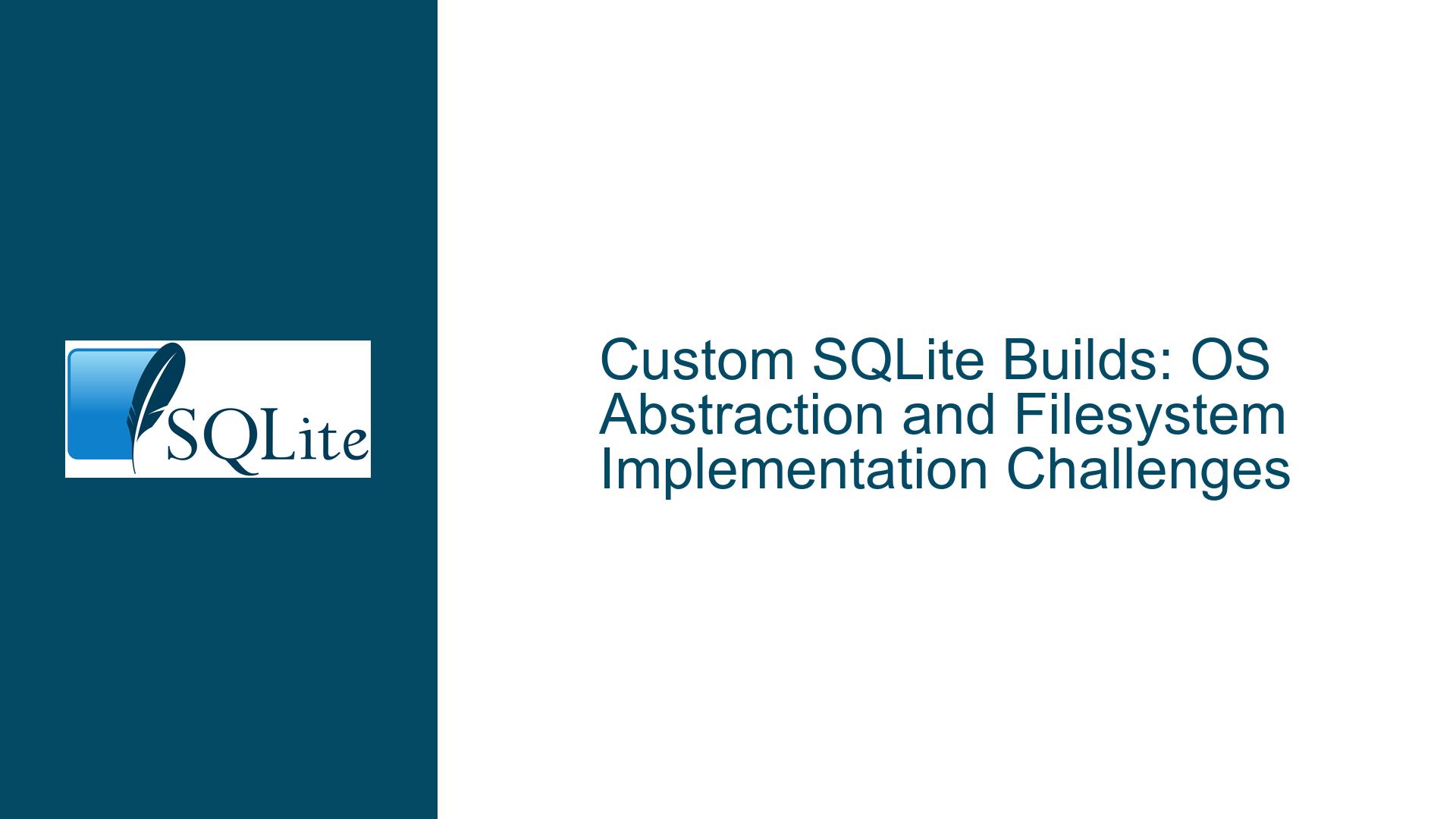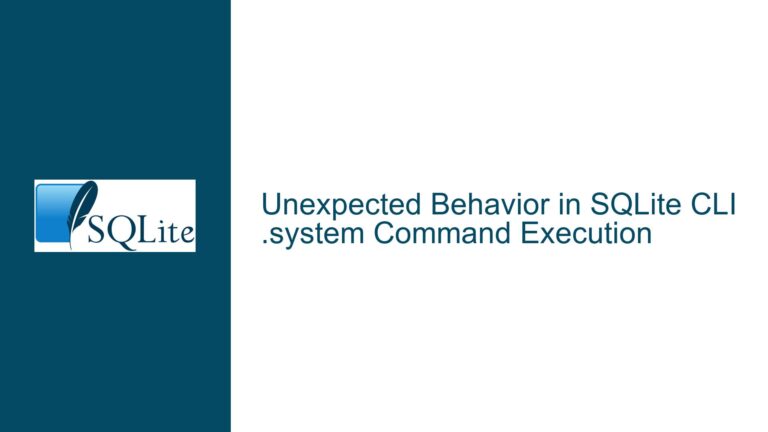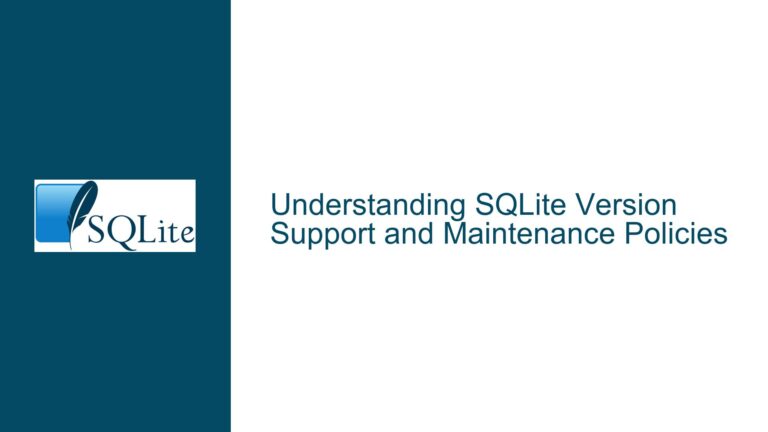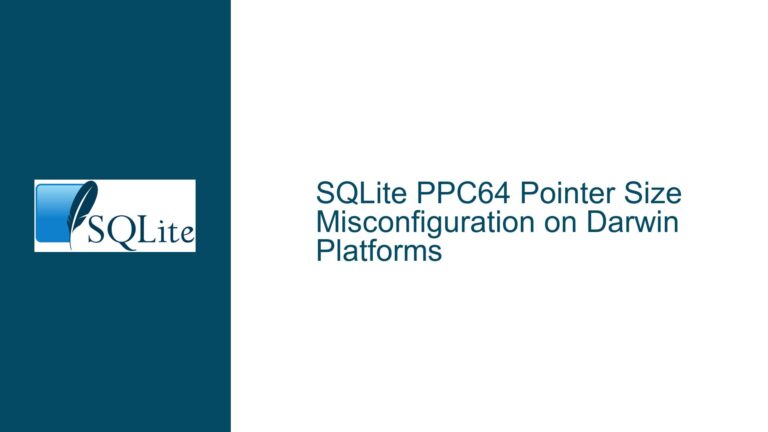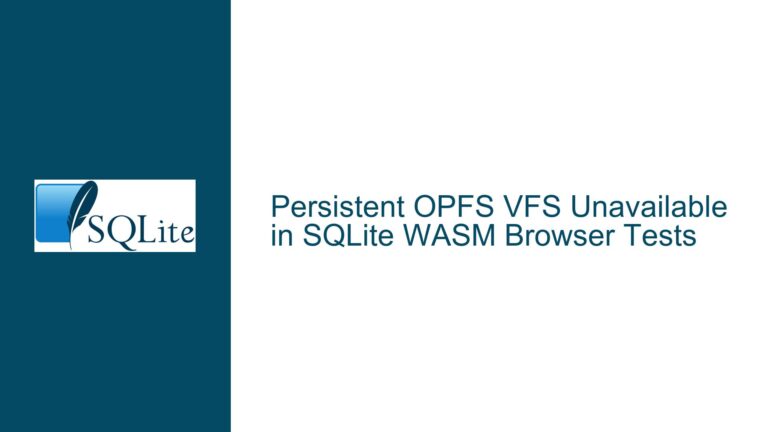Custom SQLite Builds: OS Abstraction and Filesystem Implementation Challenges
Understanding SQLITE_OS_OTHER and Filesystem Implementation Requirements
The core issues discussed revolve around two distinct but interconnected technical challenges:
- Custom Operating System Abstraction via the
SQLITE_OS_OTHERcompile-time flag, requiring manual implementation of operating system interfaces. - SQLite as a Filesystem Backend, exploring its viability for storing and managing files with ACID guarantees.
Custom OS Abstraction with SQLITE_OS_OTHER
When compiling SQLite with SQLITE_OS_OTHER=1, the build system excludes default implementations of operating system dependencies. This flag is typically used for environments where standard POSIX or Win32 system calls are unavailable, such as embedded systems, proprietary kernels, or experimental platforms. The SQLite library delegates low-level operations to a Virtual File System (VFS) layer and relies on OS-specific routines for thread synchronization, memory management, and file operations.
Key components that become undefined when SQLITE_OS_OTHER is activated include:
- VFS Methods: The
sqlite3_os_init()function, which initializes the default VFS. - Mutex Subsystem: Functions like
sqlite3_mutex_alloc(),sqlite3_mutex_enter(), andsqlite3_mutex_leave()for thread synchronization. - File Operations: System call wrappers for file I/O, directory traversal, and randomness generation.
Without these routines, SQLite cannot perform basic operations such as opening database files, handling concurrent access, or generating cryptographic-safe randomness for temporary file names. Developers must provide custom implementations of these subsystems tailored to their target environment.
Filesystem Implementation Using SQLite
The second challenge involves repurposing SQLite as a storage backend for filesystem-like operations. Traditional filesystems manage hierarchical data structures (directories, files, permissions) through inodes or similar metadata systems. SQLite’s ACID compliance and transactional guarantees make it theoretically suitable for such use cases, but practical implementation faces hurdles:
- Hierarchical Metadata: Representing directory trees and file attributes (size, timestamps) within relational tables.
- Large Object Storage: Efficiently storing and retrieving binary large objects (BLOBs) with low latency.
- Concurrency: Managing simultaneous read/write operations without excessive locking or performance degradation.
Existing projects like SQLar, libsqlfs, and experimental VFS layers (e.g., test_onefile.c) demonstrate partial solutions but highlight trade-offs in performance and complexity.
Common Pitfalls in Custom OS Abstraction and Filesystem Design
Incomplete VFS and Mutex Implementations
A frequent mistake when using SQLITE_OS_OTHER is underestimating the scope of required routines. For example, a developer might implement sqlite3_os_init() but neglect to define mutex functions, leading to crashes in multi-threaded environments. The SQLite core assumes that all OS abstractions are fully functional; partial implementations result in undefined behavior.
The VFS layer requires at least the following methods to be defined:
- File open/close, read/write, and locking primitives.
- Directory creation/removal and file existence checks.
- Randomness generation for temporary file suffixes.
Similarly, the mutex subsystem must provide atomic locks for critical sections, even in single-threaded environments, because SQLite uses mutexes internally for memory management and error handling.
Filesystem Schema Design Limitations
When using SQLite as a filesystem backend, schema design choices directly impact performance and usability. A naive approach might involve a single table storing file paths and BLOBs:
CREATE TABLE fs (path TEXT PRIMARY KEY, data BLOB, mtime INTEGER);
This design suffers from:
- Path Traversal Inefficiency: Listing directory contents requires string operations on the
pathcolumn. - Lack of Metadata: Missing support for permissions, ownership, or extended attributes.
- Transaction Overhead: Frequent commits to ensure ACID guarantees introduce latency.
Projects like libsqlfs address these issues with normalized schemas separating inodes, directory trees, and data blocks, but this increases complexity.
Concurrency and Locking Contention
SQLite’s default locking mechanisms (e.g., WAL mode) are optimized for database workloads, not filesystem-like access patterns. Concurrent writes to adjacent BLOBs or metadata tables can trigger database-level locks, serializing operations that would be parallel in traditional filesystems. Custom VFS implementations must carefully manage byte-range locks or adopt alternative concurrency models.
Step-by-Step Guidance for Custom Builds and Filesystem Integration
Implementing SQLITE_OS_OTHER Dependencies
1. VFS Initialization and Registration
Developers must define a custom VFS struct (sqlite3_vfs) and register it using sqlite3_vfs_register(). The test_onefile.c example provides a minimal template:
static sqlite3_vfs vfs = {
1, // iVersion
sizeof(OneFile), // szOsFile
MAXPATHNAME, // mxPathname
0, // pNext
"onefile", // zName
0, // pAppData
onefileOpen, // xOpen
onefileDelete, // xDelete
onefileAccess, // xAccess
// ... other method pointers
};
sqlite3_vfs_register(&vfs, 1);
Each method (e.g., xOpen, xRead, xWrite) must be implemented to interface with the host environment’s I/O capabilities.
2. Mutex Subsystem Implementation
Define a sqlite3_mutex struct with platform-specific locking:
static sqlite3_mutex_methods mutex_methods = {
myMutexAlloc,
myMutexFree,
myMutexEnter,
myMutexTry,
myMutexLeave
};
sqlite3_config(SQLITE_CONFIG_MUTEX, &mutex_methods);
Even single-threaded builds require dummy mutex functions to satisfy SQLite’s internal checks.
3. OS Interface Functions
Implement missing OS routines referenced by SQLite’s core:
sqlite3_randomness(): Can delegate to a cryptographic RNG or hardware entropy source.sqlite3_current_time64(): Provides the system time forCURRENT_TIMESTAMP.
Building a SQLite-Based Filesystem
1. Schema Design Best Practices
Adopt a hybrid schema combining normalized metadata and denormalized data storage:
CREATE TABLE inode (
id INTEGER PRIMARY KEY,
mode INTEGER, // file type and permissions
uid INTEGER,
gid INTEGER,
size INTEGER,
atime INTEGER,
mtime INTEGER,
ctime INTEGER
);
CREATE TABLE tree (
parent INTEGER REFERENCES inode(id),
name TEXT,
child INTEGER REFERENCES inode(id),
PRIMARY KEY (parent, name)
);
CREATE TABLE data (
inode INTEGER REFERENCES inode(id),
block INTEGER,
content BLOB,
PRIMARY KEY (inode, block)
);
This schema supports efficient directory traversal via the tree table and chunked storage for large files in data.
2. VFS Integration with Filesystem Schema
Develop a custom VFS that translates file operations into SQL queries:
- File Open: Query the
inodeanddatatables to load metadata and content. - File Write: Update
data.contentandinode.mtimewithin a transaction. - Directory List: Execute
SELECT name FROM tree WHERE parent = ?to enumerate entries.
The libsqlfs project demonstrates this approach by mapping POSIX filesystem calls to SQLite operations.
3. Concurrency Optimization
To mitigate locking contention:
- Use WAL Mode: Enables concurrent readers and a single writer.
- Implement Page-Level Locking: Store each filesystem block in a separate database row to allow fine-grained locking.
- Leverage In-Memory Databases: For transient or high-throughput metadata operations.
Validation and Testing
1. Unit Testing OS Abstraction
Compile SQLite with SQLITE_OS_OTHER and run the SQLite Test Suite in the target environment. Focus on tests involving file I/O, threading, and randomness.
2. Filesystem Benchmarking
Compare read/write performance against traditional filesystems using tools like fio or custom scripts. Measure latency for common operations (file creation, directory traversal) under varying concurrency levels.
3. Community Resources and Examples
- test_onefile.c: A minimal VFS implementation for single-file databases.
- SQLar: Archiving tool using SQLite for storage, demonstrating BLOB management.
- libsqlfs: POSIX-like filesystem implementation with SQLite backend.
By methodically addressing OS abstraction gaps and adopting proven schema design patterns, developers can successfully integrate SQLite into unconventional environments while avoiding common pitfalls.
